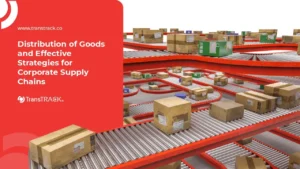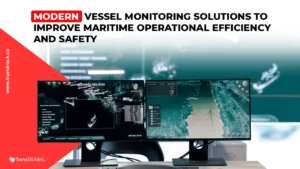Characteristics, Types, Barriers and Benefits of E-Logistics
Posted on September 15, 2023 by Nur Wachda Mihmidati

E-logistics, or electronic logistics, is a concept that refers to the use of information and communications technology (ICT) in the management, planning and implementation of logistics processes. It includes software applications, information systems and technology infrastructure to improve efficiency, visibility and control in the supply chain and distribution of goods and services.
Implementing electronic logistics can help companies reduce operational costs, increase delivery speed and efficiency, improve customer experience, and increase visibility and control in their supply chains. It’s a concept that continues to evolve as technology advances, and businesses that want to remain competitive in the digital era should consider integrating e-logistics into their operations. Check out the following TransTRACK article for more information!
Benefits of E-Logistics
E-logistics, or electronic logistics, provides a variety of benefits to companies and supply chains in various industrial sectors. Here are some of the main benefits of electronic logistics:
Operational Efficiency
E-logistics allows companies to automate many processes in the supply chain, including inventory management, order processing, and shipment tracking. This reduces delays and errors associated with manual processes, thereby increasing overall operational efficiency.
Cost Savings
By optimizing delivery routes, reducing order processing errors, and managing inventory more efficiently, companies can save significant logistics costs. This includes reducing fuel costs, labor costs, and excess inventory holding costs.
Increased Visibility
E-logistics provides better visibility of the entire supply chain. Companies can track delivery status in real-time, identify problems quickly, and provide customers with more accurate information about their deliveries.
Improved Customer Service
With the ability to provide customers with more accurate estimated arrival times and more complete delivery information, companies can increase customer satisfaction. Better customer service can help build customer loyalty and increase market share.
Better Decision Making
Data collected from electronic logistics systems can be used for deeper analysis of supply chain performance. This helps companies make better decisions in terms of planning, budgeting, and business strategy.
Easier Scalability
With a scalable e-logistics system, companies can more easily cope with fluctuations in demand or business expansion. They can adjust capacity and resources as needed without disrupting overall operations.
Better Regulatory Compliance
E-logistics can help companies comply with regulations and legal requirements in certain industries. This includes tracking tax requirements and shipping documents.
Safety and Security
E-logistics can also help improve safety and security in the supply chain. With real-time monitoring and better tracking, companies can respond quickly to incidents or emergency events.
Environmental Impact Reduction
By optimizing routes and reducing fuel consumption, e-logistics can help reduce the environmental impact of shipping activities.
Competitive in the Digital Era
In an increasingly connected and digital world, e-logistics is a way to remain competitive and innovate in the logistics industry. Companies that adopt this technology are better prepared to face future challenges.
Overall, electronic logistics is a powerful tool to increase efficiency, reduce costs, and provide better service to customers in the supply chain. This can help companies to remain competitive and successful in an ever-changing market.
Characteristics of e-logistics systems
E-logistics systems have various characteristics, and the characteristics you mentioned, namely “Anonymous Transactions,” “Unrealized goods products,” and “No limits on minimum transactions,” can be part of the characteristics of e-logistics systems. Let’s talk more about these characteristics:
Anonymous Transactions
E-logistics systems can be designed to support anonymous transactions, meaning that the identity of customers or parties involved in transactions can remain confidential or hidden. This can be important in situations where customers or related parties wish to maintain their privacy, such as in the purchase of sensitive health products or in confidential business transactions.
Intangible Goods Products (Digital Products)
E-logistics is not limited to delivering physical products only. It also includes the delivery of intangible or digital goods products, such as software, digital music, videos, e-books, or online services. These digital products can be easily downloaded or accessed via online platforms, and their delivery usually does not involve physical delivery.
There is no limit on minimum transactions
In e-logistics systems, there are often no limits on minimum transactions. This means that customers can make transactions with small or large values according to their needs. With no minimum restrictions, customers have the flexibility to purchase products or services according to their preferences and budget.
These characteristics reflect the way electronic logistics systems combine information technology with logistics to increase efficiency, flexibility, and ease in delivering products and services to customers.
Types of systems that exist in e-logistics
The following are several types of systems that exist in e-logistics, which reflect the various types of interactions and transactions that occur in the electronic environment:
B2B (Business-to-Business)
- Description: B2B is a type of e-logistics system that involves transactions and interactions between two or more companies or businesses. This includes activities such as purchasing raw materials, components, or services between companies for use in their production or operations.
- Example: An automotive manufacturer purchases parts from an electronic components supplier for use in assembling cars.
B2C (Business-to-Consumer)
- Description: B2C is a type of e-logistics system that involves transactions between companies or businesses and end consumers. This is the most common form of e-commerce and covers a wide range of products and services sold to individuals.
- Example: Online purchases of clothing, electronics, food, or services by individuals from online retailers such as Amazon or Tokopedia.
C2C (Consumer-to-Consumer)
- Description: C2C is a type of e-logistics system that involves interactions and transactions between individual consumers. It is a form of electronic commerce between individuals without involving large corporations or businesses.
- Example: Platforms such as eBay or Tokopedia that allow individuals to sell their goods to other individuals.
B2E (Business-to-Employee)
- Description: B2E is a type of e-logistics system that involves interaction between a company or business and its employees. This includes various services provided by the company to employees, such as human resources management, administration, or health services.
- Example: An online HR management system that allows employees to access their personal data, apply for leave, or view salary information.
Each type of electronic logistics system has its own characteristics and dynamics depending on the context and purpose of its use. E-logistics plays an important role in facilitating transactions and interactions among business entities, consumers and individuals in the digital environment.
Barriers to implementing e-logistics
Implementing e-logistics can provide many benefits, but also faces a number of obstacles that need to be overcome. Some of the main obstacles in implementing e-logistics include:
High Initial Costs
Implementing e-logistics technology requires significant initial investments in hardware, software, infrastructure and training. For some companies, these initial costs can be a major obstacle.
System Integration Complexity
Companies that have used traditional logistics systems often face challenges in integrating e-logistics technology into their existing infrastructure. This could require substantial internal process changes.
Difficulty Using Technology
Not all employees have the same level of technology skills. Implementing e-logistics technology can require intensive training for employees who are less familiar with new software and equipment.
Data Security and Privacy
In an e-logistics environment, sensitive data about customers, orders and supply chains must be closely guarded. Security threats and the risk of data privacy breaches are serious obstacles.
Infrastructure Issues
Not all regions have the same access to the technological infrastructure needed to support e-logistics. Issues such as poor or limited internet connectivity can be a barrier.
Regulatory Uncertainty
Changing or unclear regulations can confuse companies and influence their decisions in adopting e-logistics technology.
Physical Logistics Challenges
Although electronic logistics focuses on data and information management, there are still physical challenges associated with shipping goods. This includes problems such as traffic jams, bad weather, or damage to goods during delivery.
Lack of Awareness and Understanding
Some companies may not fully realize the potential benefits of e-logistics technology or lack understanding of how to integrate it into their operations.
Dependence on Technology
Excessive reliance on e-logistics technology can cause serious problems if system disruptions or technical failures occur.
Organizational Culture Change
Changing company culture from traditional logistics to e-logistics may encounter resistance from employees who are used to the old way of working.
Overcoming these obstacles requires planning, investment, commitment, and adaptability. Companies that successfully integrate e-logistics technology tend to gain significant benefits in terms of efficiency, productivity and customer satisfaction.
In an ever-changing and increasingly connected business world, e-logistics is no longer just an option, but an absolute necessity. Although various obstacles may arise on your journey to efficiency and speed in the supply chain, nothing should stop you.
This is where TransTRACK and our Transportation Management System (TMS) solutions come in as your reliable partners. With TMS TransTRACK, you can overcome logistics challenges and optimize your e-logistics processes easily. We provide reliable solutions for planning routes, tracking deliveries in real-time, and managing your inventory efficiently.
So, why wait any longer? It’s time to move forward in your e-logistics. Be a pioneer in integrating advanced technology in your logistics operations. Visit our website today and see how TMS TransTRACK can help you overcome obstacles and achieve success in e-logistics.
With TransTRACK, your logistics future is brighter and more efficient than ever. So, let’s move forward together towards a better future in the world of e-logistics.
Recent Post
Topic :
Recommended Articles

 Bahasa Indonesia
Bahasa Indonesia








